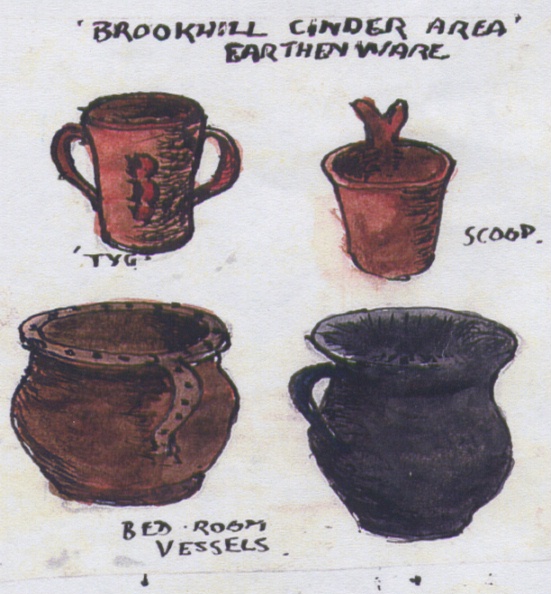
An Industrial and Pottery Walk round Buckley - Numbers 15 and 16 ( includes examples of pottery)"

Brookhill Pottery, Buckley
1967
see entry 1.239
AN INDUSTRIAL AND POTTERY WALK ROUND BUCKLEY - NUMBERS 15 AND 16
15. Retracing our steps to the Pinfold crossroad, we pass the site of the old pinfold (now the first direct building of the industrial estate) and enter the estate, which used to be worked by Catherall's and then Butterley Brick Company. Jonathan Catherall began to burn firebricks in this locality in the early eighteenth century and later established a brickworks on this site in 1760s. In October 1985, notice was publised that these works were to be closed at an early date. Kilns were being cooled down from then on and stocks of bricks removed.
Until the closure of Catherall's in November 1985, an unofficial occupant of the premises after normal working hours was Roger.
This good-natured, affable vagrant regularly kipped down in an unobtrusive corner each night. And departed each morning before work commenced. Kind-hearted residents of the town catered for his food and clothing.
16. Passing through the brickyard, alongside the fuel gasometer, one obtained a panoramic view of the north-east side of the district. It illustrates the geological and geographical factors which gave birth to the Buckley clay industry.
A deep, water-filled clayhole directly ahead, exhibits coad measures, outcropping, on the left from under the fireclays. Silica rocks form a vertical scarp face on the right. Marl coats the surface. Shales on the water's edge to the south constitue the raw material for the once world-famous "metalline" bricks.
NB. Note that the last paragraph was written about 1986. Currently (August 2002), the clayhole is being used as a refuse tip and is being built up with rubbish to form a huge mound, reminiscent of the old Knowl Hill! In time, when the hole is full, it will be capped with vegetation, the level will decrease and the area will be returned to nature.
Author: Bentley, James
Tags
Year = 1967
Landscape = Industrial
Work = Light Industry
Extra = Visual Arts
Copyright © 2015 The Buckley Society